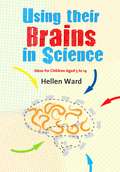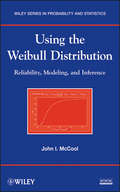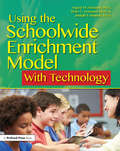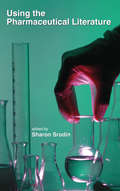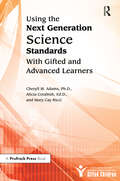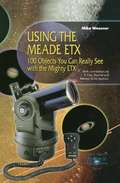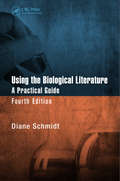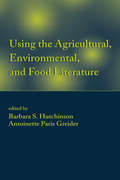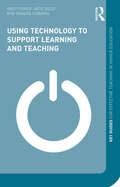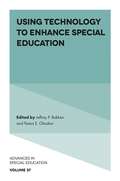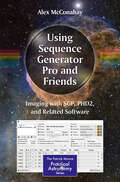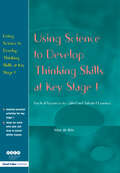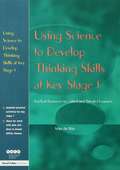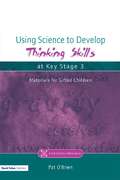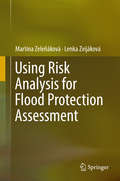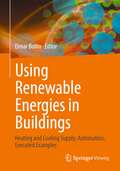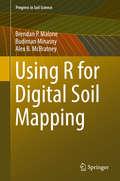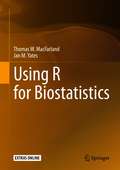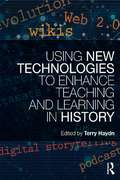- Table View
- List View
Using their Brains in Science: Ideas for Children Aged 5 to 14 (PDF)
by Hellen Ward'This is a fascinating and very useful book....I cannot recommend it highly enough. It will inspire you' - School Science Review By focusing on active ways to help 5 to 14 year olds improve their thinking and learning skills in science, this book provides teachers with inspiration and ideas for ways to teach creative, enjoyable and interesting science lessons. Linked to up-to-date research in brain-based learning, the author gives practical advice on topics including: o ways to motivate pupils o developing pupils' skills of detection o the importance of using movement to promote learning o improving pupils' language skills and understanding of scientific vocabulary o suggestions for different ways learners can record in science o effective strategies for assessing learning in science o ideas to promote creativity o the importance of using ICT to support and promote learning. This book is an inspirational read for teachers, student teachers and teaching assistants, and anyone interested in science and how children learn. Helen Ward is Senior Lecturer at Canterbury Christ Church University, Programme Director for the Modular PGCE at Christ Church and also an independent education consultant and active member of the Association for Science Education (ASE).
Using the Weibull Distribution: Reliability, Modeling, and Inference (Wiley Series in Probability and Statistics #950)
by John I. McCoolUnderstand and utilize the latest developments in Weibull inferential methods While the Weibull distribution is widely used in science and engineering, most engineers do not have the necessary statistical training to implement the methodology effectively. Using the Weibull Distribution: Reliability, Modeling, and Inference fills a gap in the current literature on the topic, introducing a self-contained presentation of the probabilistic basis for the methodology while providing powerful techniques for extracting information from data. The author explains the use of the Weibull distribution and its statistical and probabilistic basis, providing a wealth of material that is not available in the current literature. The book begins by outlining the fundamental probability and statistical concepts that serve as a foundation for subsequent topics of coverage, including: • Optimum burn-in, age and block replacement, warranties and renewal theory • Exact inference in Weibull regression • Goodness of fit testing and distinguishing the Weibull from the lognormal • Inference for the Three Parameter Weibull Throughout the book, a wealth of real-world examples showcases the discussed topics and each chapter concludes with a set of exercises, allowing readers to test their understanding of the presented material. In addition, a related website features the author's own software for implementing the discussed analyses along with a set of modules written in Mathcad®, and additional graphical interface software for performing simulations. With its numerous hands-on examples, exercises, and software applications, Using the Weibull Distribution is an excellent book for courses on quality control and reliability engineering at the upper-undergraduate and graduate levels. The book also serves as a valuable reference for engineers, scientists, and business analysts who gather and interpret data that follows the Weibull distribution
Using the Weibull Distribution: Reliability, Modeling, and Inference (Wiley Series in Probability and Statistics #950)
by John I. McCoolUnderstand and utilize the latest developments in Weibull inferential methods While the Weibull distribution is widely used in science and engineering, most engineers do not have the necessary statistical training to implement the methodology effectively. Using the Weibull Distribution: Reliability, Modeling, and Inference fills a gap in the current literature on the topic, introducing a self-contained presentation of the probabilistic basis for the methodology while providing powerful techniques for extracting information from data. The author explains the use of the Weibull distribution and its statistical and probabilistic basis, providing a wealth of material that is not available in the current literature. The book begins by outlining the fundamental probability and statistical concepts that serve as a foundation for subsequent topics of coverage, including: • Optimum burn-in, age and block replacement, warranties and renewal theory • Exact inference in Weibull regression • Goodness of fit testing and distinguishing the Weibull from the lognormal • Inference for the Three Parameter Weibull Throughout the book, a wealth of real-world examples showcases the discussed topics and each chapter concludes with a set of exercises, allowing readers to test their understanding of the presented material. In addition, a related website features the author's own software for implementing the discussed analyses along with a set of modules written in Mathcad®, and additional graphical interface software for performing simulations. With its numerous hands-on examples, exercises, and software applications, Using the Weibull Distribution is an excellent book for courses on quality control and reliability engineering at the upper-undergraduate and graduate levels. The book also serves as a valuable reference for engineers, scientists, and business analysts who gather and interpret data that follows the Weibull distribution
Using the Schoolwide Enrichment Model With Technology
by Angela Housand Brian Housand Joseph RenzulliUsing the Schoolwide Enrichment Model With Technology is an extension of a talent development model implemented in more than 2,500 schools across the U.S. and widely used internationally. More than 40 years of research and development have documented the effectiveness of the SEM approach to promoting higher level thinking skills and creative productivity. This solution-oriented book, unlike other books focused on using technology in the classroom, recognizes that digital technologies are changing and evolving at lightning speeds. Our effective skills for using technology transcend time by focusing on how to find and use digital resources and tools rather than listing the resources that already exist. Focusing on the skills that support critical thinking and problem solving, decision making, and communication, the authors seamlessly merge technology to launch students toward independent productivity. This accessible and highly practical guide is rich with examples that will change the way you think about education while providing hands-on “how-to” guidance for creating a culture of excellence and innovation in your school and classroom.
Using the Schoolwide Enrichment Model With Technology
by Angela Housand Brian Housand Joseph RenzulliUsing the Schoolwide Enrichment Model With Technology is an extension of a talent development model implemented in more than 2,500 schools across the U.S. and widely used internationally. More than 40 years of research and development have documented the effectiveness of the SEM approach to promoting higher level thinking skills and creative productivity. This solution-oriented book, unlike other books focused on using technology in the classroom, recognizes that digital technologies are changing and evolving at lightning speeds. Our effective skills for using technology transcend time by focusing on how to find and use digital resources and tools rather than listing the resources that already exist. Focusing on the skills that support critical thinking and problem solving, decision making, and communication, the authors seamlessly merge technology to launch students toward independent productivity. This accessible and highly practical guide is rich with examples that will change the way you think about education while providing hands-on “how-to” guidance for creating a culture of excellence and innovation in your school and classroom.
Using the Pharmaceutical Literature
by Sharon SrodinGathering information of critical importance for professionals in the pharmaceutical and medical device industries, this guide provides a comprehensive overview of key resources, such as databases, on-line directories, reports, and periodicals-providing at-a-glance guidance and collection development tools for information professionals in this fiel
Using the Next Generation Science Standards With Gifted and Advanced Learners
by Cheryll M. Adams Alicia Cotabish Mary RicciUsing the Next Generation Science Standards With Gifted and Advanced Learners provides teachers and administrators examples and strategies to implement the Next Generation Science Standards (NGSS) with gifted and advanced learners at all stages of development in K-12 schools. The book describes—and demonstrates with specific examples from the NGSS—what effective differentiated activities in science look like for high-ability learners. It shares how educators can provide rigor within the new standards to allow students to demonstrate higher level thinking, reasoning, problem solving, passion, and inventiveness in science. By doing so, students will develop the skills, habits of mind, and attitudes toward learning needed to reach high levels of competency and creative production in science fields.
Using the Next Generation Science Standards With Gifted and Advanced Learners
by Cheryll M. Adams Alicia Cotabish Mary RicciUsing the Next Generation Science Standards With Gifted and Advanced Learners provides teachers and administrators examples and strategies to implement the Next Generation Science Standards (NGSS) with gifted and advanced learners at all stages of development in K-12 schools. The book describes—and demonstrates with specific examples from the NGSS—what effective differentiated activities in science look like for high-ability learners. It shares how educators can provide rigor within the new standards to allow students to demonstrate higher level thinking, reasoning, problem solving, passion, and inventiveness in science. By doing so, students will develop the skills, habits of mind, and attitudes toward learning needed to reach high levels of competency and creative production in science fields.
Using the Meade ETX: 100 Objects You Can Really See with the Mighty ETX (The Patrick Moore Practical Astronomy Series)
by Mike WeasnerThe Meade ETX range of telescopes is one of the most successful ever made. It is low-cost, has sold in its tens of thousands, and is available in almost every country. Here, ETX expert Mike Weasner reveals everything any amateur astronomer ever wanted to know about the telescope. First book dedicated entirely to the ETX. Written by an acknowledged world authority. Describes the "best" 100 objects to begin observing. Contains detailed hints and tips aimed at getting the best out of the ETX. Features imaging (photographic and digital) as well as visual observing.
Using the Biological Literature: A Practical Guide, Fourth Edition
by Diane SchmidtThe biological sciences cover a broad array of literature types, from younger fields like molecular biology with its reliance on recent journal articles, genomic databases, and protocol manuals to classic fields such as taxonomy with its scattered literature found in monographs and journals from the past three centuries. Using the Biological Litera
Using the Agricultural, Environmental, and Food Literature
by Barbara S. Hutchinson Antoinette Paris-GreiderThis reference provides the groundwork, tools, and terminology required when conducting specialized searches for information and resources pertaining to traditional and emerging fields of agriculture. The editors present 16 contributions from librarians and other information workers that offer information on research resources across the academic a
Using Technology to Support Learning and Teaching: A Practical Approach (Key Guides for Effective Teaching in Higher Education)
by Andy Fisher Kate Exley Dragos CiobanuThe climate of Higher Education is changing rapidly. The students are more likely to see themselves as consumers and have increasingly high expectations regarding teaching and learning. Universities are in part aiming to meet this need by increasing the use of technology; for example, whether to increase access to teaching materials outside the classroom or to make lectures more interactive. Although there is no illusion amongst Higher Education intuitions that technology is a panacea, it is clear that technology is a vital tool in meeting expectations and one that will be used more and more. Consequently the context of this book is one in which technology needs to be understood as part of an overall teaching practice. Technology continues to move on a pace and is used increasingly within Higher Education to support and enhance teaching and learning. There are books which are steeped in technical detail and books which are steeped in theoretical pedagogy with little discussion about the impact on learning and student/teacher behaviour. Using Technology to Support Learning and Teaching fills a gap in the market by providing a jargon free (but pedagogically informed) set of guidance for teaching practitioners who wish to consider a variety of ways in which technology can enrich their practice and the learning of their students. It integrates a wide range of example cases from different kinds of HE institutions and different academic disciplines, illustrating practicable pedagogies to a wide range of readers. It is full of advice, hints and tips for practitioners wanting to use technology to support a style of teaching and learning that is also built on sound pedagogical principles. It will provide a quick user-friendly reference for practitioners wanting to incorporate technology into Higher Education in a way that adheres to their learning principles and values . This book is primarily for teaching practitioners, particularly those who are new to the industry.This book would also prove useful on training courses for practitioners; such as the Postgraduate Certificate for Higher Education. The authors also intend that the book be of value to newer teachers (perhaps taking teacher training programmes) who wish to see where recommended approaches link to pedagogy.
Using Technology to Support Learning and Teaching: A Practical Approach (Key Guides for Effective Teaching in Higher Education)
by Andy Fisher Kate Exley Dragos CiobanuThe climate of Higher Education is changing rapidly. The students are more likely to see themselves as consumers and have increasingly high expectations regarding teaching and learning. Universities are in part aiming to meet this need by increasing the use of technology; for example, whether to increase access to teaching materials outside the classroom or to make lectures more interactive. Although there is no illusion amongst Higher Education intuitions that technology is a panacea, it is clear that technology is a vital tool in meeting expectations and one that will be used more and more. Consequently the context of this book is one in which technology needs to be understood as part of an overall teaching practice. Technology continues to move on a pace and is used increasingly within Higher Education to support and enhance teaching and learning. There are books which are steeped in technical detail and books which are steeped in theoretical pedagogy with little discussion about the impact on learning and student/teacher behaviour. Using Technology to Support Learning and Teaching fills a gap in the market by providing a jargon free (but pedagogically informed) set of guidance for teaching practitioners who wish to consider a variety of ways in which technology can enrich their practice and the learning of their students. It integrates a wide range of example cases from different kinds of HE institutions and different academic disciplines, illustrating practicable pedagogies to a wide range of readers. It is full of advice, hints and tips for practitioners wanting to use technology to support a style of teaching and learning that is also built on sound pedagogical principles. It will provide a quick user-friendly reference for practitioners wanting to incorporate technology into Higher Education in a way that adheres to their learning principles and values . This book is primarily for teaching practitioners, particularly those who are new to the industry.This book would also prove useful on training courses for practitioners; such as the Postgraduate Certificate for Higher Education. The authors also intend that the book be of value to newer teachers (perhaps taking teacher training programmes) who wish to see where recommended approaches link to pedagogy.
Using Technology to Enhance Special Education (Advances in Special Education #37)
by Jeffrey P. Bakken Festus E. ObiakorUsing Technology to Enhance Special Education, Volume 37 of Advances in Special Education, is a logically, thoughtfully organized, and well-sequenced text. It focuses on how general and special educators can use technology to work with children and youth with disabilities. This cutting-edge book involves researchers, scholars, educators, and leaders who are knowledge producers in the field. It is written to respond to today’s changing world where technology has become a very powerful force. As it stands, the world is getting smaller and smaller; and what is happening in a location quickly becomes known everywhere. For example, during the tense periods of the global COVID pandemic, technology became the livewire of our world. This book begins with an introduction to technology and students with disabilities; and the remaining chapters focus on the role of technology in the education of students with learning disabilities, emotional and/or behavioral disorders, and intellectual disabilities, autism spectrum disorders, physical and health impairments, hearing impairments/deafness, visual impairments, and traumatic brain injuries. In addition, some chapters focus on the role of technology in achieving equitable and inclusive education, building culturally and linguistically responsive general and special education, and creatively using digital comics to improve written narratives. In the end, this book concludes with a chapter that forward looking ways to infuse technology in special education. We feel that this volume is an excellent resource for special education researchers, scholars, practitioners, and professionals who teach and serve students with disabilities.
Using Technology to Enhance Special Education (Advances in Special Education #37)
by Christi U. EdgeUsing Technology to Enhance Special Education, Volume 37 of Advances in Special Education, is a logically, thoughtfully organized, and well-sequenced text. It focuses on how general and special educators can use technology to work with children and youth with disabilities. This cutting-edge book involves researchers, scholars, educators, and leaders who are knowledge producers in the field. It is written to respond to today’s changing world where technology has become a very powerful force. As it stands, the world is getting smaller and smaller; and what is happening in a location quickly becomes known everywhere. For example, during the tense periods of the global COVID pandemic, technology became the livewire of our world. This book begins with an introduction to technology and students with disabilities; and the remaining chapters focus on the role of technology in the education of students with learning disabilities, emotional and/or behavioral disorders, and intellectual disabilities, autism spectrum disorders, physical and health impairments, hearing impairments/deafness, visual impairments, and traumatic brain injuries. In addition, some chapters focus on the role of technology in achieving equitable and inclusive education, building culturally and linguistically responsive general and special education, and creatively using digital comics to improve written narratives. In the end, this book concludes with a chapter that forward looking ways to infuse technology in special education. We feel that this volume is an excellent resource for special education researchers, scholars, practitioners, and professionals who teach and serve students with disabilities.
Using Sequence Generator Pro and Friends: Imaging with SGP, PHD2, and Related Software (The Patrick Moore Practical Astronomy Series)
by Alex McConahayThis guide is specifically aimed at those who are using—or want to use—Sequence Generator Pro. SGP is a “session management” software package that controls the telescope, mount, camera, and ancillary equipment to target and secure images during a night of imaging astronomical objects.The book begins with a special tutorial to get up and running with SGP. With a comprehensive reference section, it takes the user in detail through the various aspects of user and equipment profiles, equipment definitions, the sequencer, and other essential elements of SGP. Finally, it focuses on how to get the most out of the ancillary programs—target databases, autoguiders, plate solvers, planetarium software, and other applications.Oftentimes, technical guides can end up being far denser than the processes they intend to explain. Many of the insights provided by SGP expert Alex McConahay are beyond what can be found in the official program documentation. In this book, the reader will find in-depth, yet straightforward practical advice on how to automate nightly astroimaging sessions with Sequence Generator Pro.
Using Science to Develop Thinking Skills at KS1
by Max de BooThis work presents a series of practical activities designed to help teachers build an effective science curriculum for more able children. Activities range from short discussion topics and problems to solve, to whole-day masterclasses.
Using Science to Develop Thinking Skills at KS1
by Max de BooThis work presents a series of practical activities designed to help teachers build an effective science curriculum for more able children. Activities range from short discussion topics and problems to solve, to whole-day masterclasses.
Using Science to Develop Thinking Skills at Key Stage 3
by Pat O'BrienThis book presents a series of practical activities designed to help teachers build an effective science curriculum for more able children.
Using Science to Develop Thinking Skills at Key Stage 3
by Pat O'BrienThis book presents a series of practical activities designed to help teachers build an effective science curriculum for more able children.
Using Risk Analysis for Flood Protection Assessment
by Martina Zeleňáková Lenka ZvijákováThis book explores the benefits of using risk analysis techniques in the evaluation of flood protection structures, and examines the results of the environmental impact assessment for selected planned flood protection projects. The objective of the book is to propose a methodology for environmental impact assessment in water management. In more detail, flood mitigation measures are investigated with the aim of selecting the best option for the approval process. This methodology is intended to streamline the process of environmental impact assessment for structures in the field of the water management. The book’s environmental impact assessment system for water management structures analyzes the respective risks for different options. The results are intended to support the selection of future projects that pose minimum risks to the environment. Comparison of alternatives and designation of the optimal variant are implemented on the basis of selected criteria that objectively describe the characteristics of the planned alternatives and their respective impacts on the environment. The proposed Guideline for environmental impact assessment of flood protection objects employs multi-parametric risk analysis, a method intended to not only enhance the transparency and sensitivity of the evaluation process, but also successfully addresses the requirements of environmental impact assessment systems in the European Union. These modifications are intended to improve the outcomes of the environmental impact assessment, but may also be applied to other infrastructure projects. The case study proves that the primary aim – to improve transparency and minimize subjectivity in the environmental impact assessment process specific to flood protection structure projects – is met for the planned project in Kružlov, Slovakia.
Using Renewable Energies in Buildings: Heating and Cooling Supply, Automation, Executed Examples
by Martin Becker Ekkehard Boggasch Elmar Bollin Mathias Fraaß Alfred Karbach Peter Ritzenhoff Dieter StriebelDieses Fachbuch gibt eine kompakte Übersicht über regenerative Systeme zur Wärme- und Kälteerzeugung. Einbindungs- und Automatisierungsschemata ermöglichen einen schnellen Überblick. Es werden die Grundlagen zum Regelverhalten von Systemen zur regenerativen Energienutzung dargestellt. Praxisbeispiele zeigen anschaulich Standardlösungen zur Einbindung von regenerativen Energiequellen.
Using R for Digital Soil Mapping (Progress in Soil Science)
by Brendan P. Malone Budiman Minasny Alex B. McBratneyThis book describes and provides many detailed examples of implementing Digital Soil Mapping (DSM) using R. The work adheres to Digital Soil Mapping theory, and presents a strong focus on how to apply it. DSM exercises are also included and cover procedures for handling and manipulating soil and spatial data in R. The book also introduces the basic concepts and practices for building spatial soil prediction functions, and then ultimately producing digital soil maps.
Using R for Biostatistics
by Thomas W. MacFarland Jan M. YatesThis book introduces the open source R software language that can be implemented in biostatistics for data organization, statistical analysis, and graphical presentation. In the years since the authors’ 2014 work Introduction to Data Analysis and Graphical Presentation in Biostatistics with R, the R user community has grown exponentially and the R language has increased in maturity and functionality. This updated volume expands upon skill-sets useful for students and practitioners in the biological sciences by describing how to work with data in an efficient manner, how to engage in meaningful statistical analyses from multiple perspectives, and how to generate high-quality graphics for professional publication of their research. A common theme for research in the diverse biological sciences is that decision-making depends on the empirical use of data. Beginning with a focus on data from a parametric perspective, the authors address topics such as Student t-Tests for independent samples and matched pairs; oneway and twoway analyses of variance; and correlation and linear regression. The authors also demonstrate the importance of a nonparametric perspective for quality assurance through chapters on the Mann-Whitney U Test, Wilcoxon Matched-Pairs Signed-Ranks test, Kruskal-Wallis H-Test for Oneway Analysis of Variance, and the Friedman Twoway Analysis of Variance. To address the element of data presentation, the book also provides an extensive review of the many graphical functions available with R. There are now perhaps more than 15,000 external packages available to the R community. The authors place special emphasis on graphics using the lattice package and the ggplot2 package, as well as less common, but equally useful, figures such as bean plots, strip charts, and violin plots. A robust package of supplementary material, as well as an introduction of the development of both R and the discipline of biostatistics, makes this ideal for novice learners as well as more experienced practitioners.
Using New Technologies to Enhance Teaching and Learning in History
by Terry HaydnNearly all history teachers are interested in how new technology might be used to improve teaching and learning in history. However, not all history departments have had the time, expertise and guidance which would enable them to fully explore the wide range of ways in which ICT might help them to teach their subject more effectively. This much-needed collection offers practical guidance and examples of the ways in which new technology can enhance pupil engagement in the subject, impact on knowledge retention, get pupils learning outside the history classroom, and help them to work collaboratively using a range of Web 2.0 applications. The chapters, written by experienced practitioners and experts in the field of history education and ICT, explore topics such as: how to design web interactivities for your pupils what can you accomplish with a wiki how to get going in digital video editing what to do with the VLE? making best use of the interactive whiteboard designing effective pupil webquests digital storytelling in history making full use of major history websites using social media. Using New Technologies to Enhance Teaching and Learning in History is essential reading for all trainee, newly qualified and experienced teachers of history. It addresses many of the problems, barriers and dangers which new technology can pose, but it also clearly explains and exemplifies the wide range of ways in which ICT can be used to radically improve the quality of pupils’ experience of learning history.
